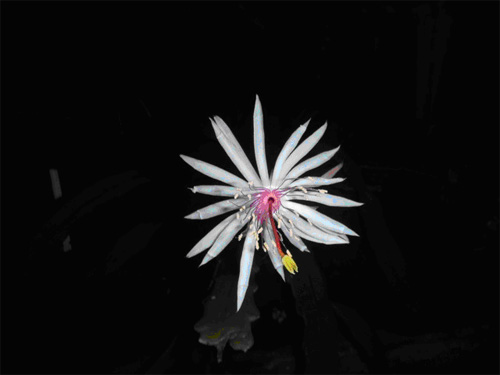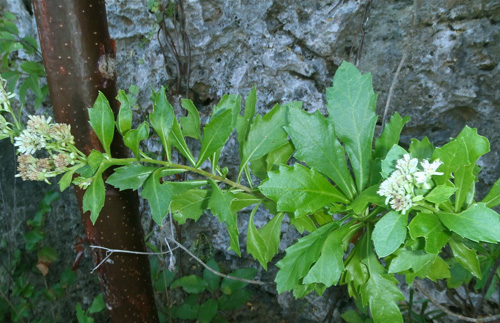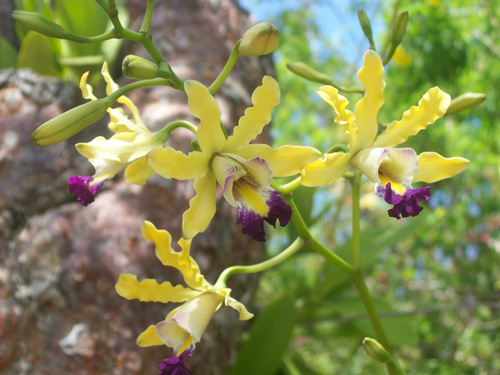SHALL WE GATHER FOR THE SEED BANK?
My own nature ethic
On my island, I and some friends possess a list of the all the native plants, ranked in order of endangerment. Some are unique to our island. We know where to find virtually all the plants. Shall we assist the Millennium Seed Bank, which wants them to deep freeze the seeds? Shall we do the following to accomplish this:
- find each species and get the coordinates of a specimen on our GPS device?
- make a table of the month of flowering, fruiting and ripening for each?
- disseminate the table to others (experts, fellow native plant enthusiasts) so we can hit the trail to gather the seeds for banking?

The whole thing gives me pause. I keep asking myself ethical questions: Can we trust ourselves not to abuse this knowledge? Should we trample paths to these hidden jewels? Will the international group sell some of the seeds to plant fanciers, seed and chemical companies, now or in the future? As it happens, it’s a dangerous field of activity. Dupont has just caught thieves stealing trade secrets on behalf of a foreign power (guess which one).
With a click we can get the coordinates, with another we can send them to someone — proudly perhaps, or “in the interests of science”. But it’s just too easy these days for the information to fall into the wrong hands.
Can our own nature organization be trusted not to mess about with the seeds, or the native bush and habitat where the source plants are found? They have proposed doing just that on several occasions! Some of the members, people I respect, have proposed artificial enclosures, breeding of animals, trading plants from island to island, seeding out rare plants, even ripping them out from the sites where they evolved to plant in other places, even in protected natural areas. A few members have already done so.
Finally, can I trust myself to do no harm? “Do no harm” is a high principle and may be violated by mindless tromping about/ Instead, I should be working tirelessly to protect these natural areas. I should educate and lobby to leave the plants alone, to follow their ancient mandate. We need to “let it be”, and to leave our wildlife wild.
My own nature ethic. I must think it out, write it out, live by it and try to promote it. So now, I’m thinking as I write.

Where are we in human history?
1. When I was a boy the world was mostly ocean, jungle, forest, roaring rivers, streams, lakes, frozen tundra, glacier, natural savannah and desert. (Whether or not the savannah and desert came before early man is not completely understood.) The human population was 2 billion, then 3 billion. (That’s a lot.) One hundred years before that, in the New World, I might have been an enthusiastic tree cutter. Now it is 7 billion. We have a plague of humans.
The world is mostly city, town, village, clearing, burned-over area, farm and abandoned farm. The ocean is warmer and has a severe chemical headache, the tundra is visibly thawing and the glaciers are receding at the most rapid rate we have seen or been able to calculate from previous eras. All this, and I’m only 74 years old.
So I am a preservationist of disappearing forest, bush, natural savannah, even desert and definitely, of ocean, stream, river and lake. Some would call me radical.
Who is radical, the one who wishes to preserve nature in all its mystery, diversity and glory? Or the ones who destroy it every day, in almost all our actions. Some love to watch nature on the tube, especially the occasional drama — so don’t we want to keep it?
Why is this important?
On the evidence, I strongly believe that man-driven development is destroying nature, that the search for money and ever-higher GNP through “growth” and “development” all represent a pox on the earth. “Forest management”, is fine if your forest is nothing but a lumber factory, but otherwise represents a brave new world of pretending that we can second-guess nature. Seed banking fits in that brave new world. Man’s hubris can actually destroy us all. It’s destroying us now – how can we not be working at this moment to arrest the decline of the natural world? We install monocultures in place of the incredible diversity of life. (I’m fond of citing Dr. Proctor’s information (Flora of the Cayman Islands): there are 500 species in the Capparis family of trees and plants of which only one produces a product that people consider useful (capers). Yet on our island, with only two members of the family, Capparis supports an annual production of millions of white butterflies, like snow. We love it. What other services does nature provide, that we don’t even know about?
We try to decide, like a communist economy, what the forest needs. We actually think we can compete with nature, which when left alone is the world’s most adaptive machine, and has handled everything thrown at it — from repeated inundation, earthquakes, volcanoes, asteroid collisions, droughts and fires to hurricanes (the least destructive of this list, perhaps).
I believe that the last, best world was pre-Columbian America, north and south, when men were few in number and had to fit in to nature’s immemorial scheme, dating back a billion years. This was the world with a future. That future proceeded in a reasonably orderly fashion until some major steps in man’s “advance” in civilization: the “invention of invention”, of machines, of stable money, of capital, of the nation state, of credit and national debt, of the automobile, of mass production, of television and in general, the invention of mass society. Even the invention of antibiotics, of safe water and sewage systems and other good things have played a part in allowing the human population to take off in a spree of exploiting nature. We now have the morality (immorality) the motive and the means to be totally exploitive of both land and sea. It’s total war against nature.
In this milieu I have dedicated myself to a battle to keep some scrap of the wilderness wild, for evolution to continue to play its slow but inexorable hand, with people fitting in, watching for harmful anomalies such as rare diseases that may creep out of the jungle. (But more likely, out of our chemical dumps, modified granaries and artificial barnyards.) We need to learn to leave nature alone.
“Let it be”, was a famous slogan to encourage us to allow wolves to range the northern forest. The slogan can now be modified to “Let it bee” to preserve a whole class of insects that is apparently being knocked out by chemical companies and yes, by chemists and by farmers large and small.
The threat is not the odd disease in the Amazon jungle, it is the destroyed jungles of Java and Nigeria, the ruined countryside of Haiti, of China, the polluted rivers, all the natural systems devastated by man gone mad, blasted by our fires, machetes and yellow crawling machines, smelters large and small, agri-business, the heedless pursuit of what I want today, never mind what the earth including humanity needs to keep for tomorrow and for all time.
Native plants have only enemies. Can I become their friend?
Consider the forces ranged against plants here on Cayman Brac. They established themselves on a dry limestone island that rose from the sea (several times, actually). Natural forces beat at them: the cauldron of the first days of earth … then storms, high seas, screaming winds, natural fires … and yet they persevered. Some of these agencies actually helped bring our plants to this rock in the northwestern Caribbean. Birds came and plant material floated in, blew in, and sometimes stuck. Some took hold in the dust blown here on the jet stream. Even natural fires played a role. Continents drifted, volcanoes blasted, earthquakes shook but our greenery took hold and held.
Every force, and still they survived.
Now WE came along, very recently but devastatingly. We cleared land for every conceivable purpose — replanting in monocultures for food, vegetable oil, lumber, building, paper, fabrics, even in some countries for rubber. Burning of land to re-plant became simply burning for burning’s sake. Fossil fuel was found beneath the surface and was burned to move the vehicles on the rubber that was grown in the monocultures. The fossil fuels were converted to rubber and chemicals too. All added to the horrible load borne by the earth, land and sea– chemicals, dust, a fished-out sea, ruined ponds, lakes, rivers and streams, acid rain, poisoned rivers, a witches’ brew. The human population now soared out of control — upward, ever upward.
The world was over-exploited by man, perhaps from day one, but the Americas were exploited later, especially from the time of European “contact”. We on our tiny island came later still (1830s) … but we quickly made up for lost time. Ask the crocs or “caimans” that once lived here). Contact has been devastating and now threatens the future of life on earth, ourselves included.
Plants have enemies: illegal miners, legal open-pit miners, plant thieves, palm oil growers, squatters, lumber cutters, slash-and-burners, nice people like do-gooders and bougainvillea planters, horticulturalists, orchid society members, various scientists, backyard gardeners, cross-pollinators and just ordinary proles like me.
Yes, scientists and collectors have added to the pressure on our plant life. Orchid collectors pay poor children to strip the forests. (I saw this first hand; also saw collectors pay kids to collect rare butterflies, in Papua New Guinea.)
We came late to this island but the tools were readily available and we rushed to slash and burn and plant, and lately, to strip our island quite alarmingly and systematically. We went from machetes to dynamite and yellow machines, and graduated to serious for aggregate production for export. Today I studied yet more proposals to “develop” our already most-modified island, out of the three in this small island chain.
Is it too late?
Not here.
Are you a good demographer? Then look around the world and calculate how many young people can reach a place of natural, undisturbed wonder, virtually unchanged from aboriginal times, by merely walking from their own house (tent, apartment or other abode). It can’t happen in New York or any major city, nor in a refugee camp, nor in a slum, nor in a city where you can’t even sneeze without getting into a car to do so. It’s a rarity, being able to explore truly virgin bush.
But it’s still possible for our young people here on Cayman Brac. You can do it too. If you don’t believe me, phone and we’ll walk from your house together, until we arrive in a mysterious place, albeit a little bit scratched from trees and “wiss” (withes, to some). We’ll find a place of total silence, perhaps a place where nobody has ever stood before. A place where you’ll see something surprising – an unknown air plant, a mysterious cave, a long-nosed green anole or a solder crab in a marine snail that you’ve never seen before in spite of all your beach combing. Here on our island, we’re not yet fully blasted, pulverized, bulldozed, paved, compacted, air conditioned, bought, built upon, rolled, road- signed, mortgaged, hedge funded, paid, pensioned and gentrified.
So what shall we do?
Given all this, shall we help scientists and collectors roam in the bush to find rarities, marking their coordinates for all the world, stripping out their seeds for … for what? To add to others’ collections? To sell for experiments? To sell to collectors? “See this now – rare clone of blue and green Blitheringalissiae obscuranteae?” Isn’t this just another assault on the now-rare wild habitats of the world?
No. It must not be so. Millennium Seed Bank? I call it Apocalypse Seed Bank. It is the invention of minds already dead. For every dollar spent on this, we could set aside a square foot of land and keep it wild. We can encourage others to do the same.
I must dedicate myself to saving not the individual species, but too, the habitats in which they evolved. I must encourage my adopted country to set aside great swaths of natural habitat to continue untouched, to “manage” themselves without our stumbling, interfering hands. I do not want to gather wild seeds on our not- yet- completely defoliated land. I’d rather try to save one-half of the total area and keep it natural, forever.
Slow the developers;
Slow the hedge funds;
Slow, even reverse, the growth of our human population;
Same with our cats, dogs, chickens and rats which follow us in train;
Slow the growth of the GDP;
Slow the onset of high walls, of “gated communities”. (Here??)
Keep the place livable so a stable population can thrive in a lovely, green place, with peace and quiet, with respect for each other.
No walls, no rapacious clearing, cutting, burning, quarrying; just good uses of the land for decent human needs while respecting our fellow creatures and plants. Only the benign human pleasures of honest work, hiking, biking, snorkeling and swimming, making love to the sound of the Rainbird and to the tickle of the sea breeze.
I can develop my own, strict protocol
OK, I’ve decided for myself. I will never take a wild plant from its natural habitat. Even if I find one orphaned by a yellow machine I will not plant it in the wild, only in my backyard, and then with regret (since it may die anyway). Further, I will not import seeds, plants or cuttings or plants for decorative uses. Can’t we get along with our beautiful native trees and plants – Broadleaf, Candlewood, almost a thousand native plant and tree species? Look what happened when some ill-informed person brought “Brazilian pepper” here — hazardous to all but spreading uncontrollably. Even importation for vegetable and fruit gardening should be strictly controlled.

My nature ethic: seed collection just doesn’t fit in
The big organization says it won’t condone sending seeds from one island to another (except to the central seed bank of course). But I won’t move a plant even one foot from where I found it. Nature ethic – this is my manifesto.
- Rare plants can be studied and admired in place – I don’t want to collect them. I will never compromise the ability of the plant to live its natural life, following its endless, evolutionary path. (By the way, our native orchids used to be harvested here. Perhaps still are. So I’m not just talking theory.)
- I will never plant anything in our protected areas, not even from one corner to another, nor even one foot away from its original site;
- I will never create smooth trails to rare or to any plants — they simply smooth the way for foreign agents like cats, rats, chickens, dogs and man;
- I will never buy, sell, trade or give away wild seeds;
- If some entrepreneur wishes to raise and sell small, local seedling trees and plants, this is ok but I can encourage them to subscribe to the values listed here. Mahogany was over-harvested and could be re-planted in pasture and scrubland;
- No vehicles should ever enter our protected natural areas, nor should roads intrude;
- I will never condone modification of our protected natural areas; the idea of “management” of such areas begs the question: who “managed” them for eons prior to the arrival of man on the scene? (One natural area is said to require $25,000 for management. It needs ZERO dollars unless it needs to be fenced to keep out chickens)
- I will work to keep out botanical parks from our island, and other places where gathering wild materials, purchase/sale of growing materials, the planting out of growing materials, the hybridization of plants, and other practices would take place.
Larger islands and countries can make their own decisions. They are less subject to damage than our very small island. But for us, no botanic park please. No zoos, petting zoos, no feeding of wild animals especially iguanas and others that can become inured to humans and their cars. Feeding of waterfowl and other wild creatures ruins their nutrition and I will encourage an outright, enforced ban as is practiced in other jurisdictions. (Zoos are being broken up in Costa Rica, I note with satisfaction.)
As well as dedicating one-quarter of all of our land, shore and inshore area to nature, the areas where we ourselves reside should also be wildlife-friendly: safe for birds, butterflies, iguanas, all the native creatures. Around my house I’ll share “my own territory” including our yard with those birds and wild creatures that can tolerate me, without feeding them on the one hand or threatening them with felines on the other. I will in fact work to keep out the menace of felines and other non-native predators.
In short, some of Cayman Brac, perhaps one quarter, should be reserved for wild nature. The remainder of Cayman Brac should be shared with our natural companions, with respect for their ways. They enhance our lives!
This is my protocol for myself. I guess it’s a bit of a manifesto. Thank you for reading to the end. I’m amazed.
jwp

